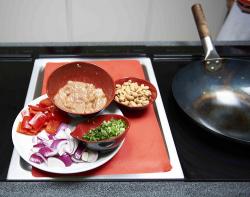 ‘It’s more of a gentle movement really,’ says Jeremy Pang moving swiftly out of range as I attempt to redecorate his class kitchen with the contents of my wok.’A gentle push forward and then a flick. Just relax’, he adds as I spatter some more onion about the place.
‘It’s more of a gentle movement really,’ says Jeremy Pang moving swiftly out of range as I attempt to redecorate his class kitchen with the contents of my wok.’A gentle push forward and then a flick. Just relax’, he adds as I spatter some more onion about the place.
I’m actually cooling down the wok’s contents. You don’t adjust the flame under a wok if things get smoky, you just lift it off the hob for a moment and flick the contents over, it’s enough to dump the excess heat before the wok goes straight back on for more sizzling.
 Many of us have a wok in our kitchen, for some it’s a white elephant, largely unused and taking up space. But even those of us who fancy ourselves as hard wokers, rarely get the all-important technique right.’People end up braising food in the, wok not frying it, because they don’t know how to keep things moving and keep the heat high,’ Le Cordon Bleu trained chef Jeremy explained earlier as he prepped the simple ingredients: sliced chicken thigh, red pepper, onions, cashews and spring onions with plenty of Szechuan peppers. The last would deliver a citric tang and a strange numbing sensation on the tongue but, despite their name, no heat at all. That was to come from a big bowl of sliced birds eye chillies.’You like chilli?’ enquired Jeremy as he sliced away,’that’s good!’.
Many of us have a wok in our kitchen, for some it’s a white elephant, largely unused and taking up space. But even those of us who fancy ourselves as hard wokers, rarely get the all-important technique right.’People end up braising food in the, wok not frying it, because they don’t know how to keep things moving and keep the heat high,’ Le Cordon Bleu trained chef Jeremy explained earlier as he prepped the simple ingredients: sliced chicken thigh, red pepper, onions, cashews and spring onions with plenty of Szechuan peppers. The last would deliver a citric tang and a strange numbing sensation on the tongue but, despite their name, no heat at all. That was to come from a big bowl of sliced birds eye chillies.’You like chilli?’ enquired Jeremy as he sliced away,’that’s good!’.
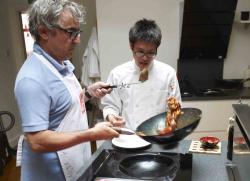 The class kitchen at School of Wok is smart and shiny, at least when no one is scattering food about. Induction hobs in the main, perfectly ok for woks when fitted with a small stand, and a fabulous AEG induction wok hob, basically a large depression in the work surface, that I immediately want to have at home as it’s so sexy and perfect.
The class kitchen at School of Wok is smart and shiny, at least when no one is scattering food about. Induction hobs in the main, perfectly ok for woks when fitted with a small stand, and a fabulous AEG induction wok hob, basically a large depression in the work surface, that I immediately want to have at home as it’s so sexy and perfect.
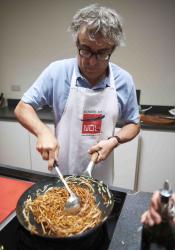 ‘The order of preference for home wok cooking I’d say is gas first, then induction, then electric,’ says Jeremy, his large cleaver making short work of some spring onions.’I’ve carried out wok classes in peoples’ homes and really there is nothing that won’t work, although with electric a flattish-bottomed wok’s best, but not,’ he adds sternly waving the cleaver for emphasis,’one of those completely flat bottomed ones, you can’t move the food around properly in those.’
‘The order of preference for home wok cooking I’d say is gas first, then induction, then electric,’ says Jeremy, his large cleaver making short work of some spring onions.’I’ve carried out wok classes in peoples’ homes and really there is nothing that won’t work, although with electric a flattish-bottomed wok’s best, but not,’ he adds sternly waving the cleaver for emphasis,’one of those completely flat bottomed ones, you can’t move the food around properly in those.’
They carry out cookery courses non stop at School of Wok, including day long Chinese cooking lessons and Vietnamese evening lessons too, but I’m taking the one hour Quickfire Wok lesson designed to get some vital skills learnt in less than a lunch hour. ‘We prep, you cook,’ Jeremy told me as I strapped on my apron.’We want you to get properly hands on with the wok, so we prepare everything in advance, but I will show you how to marinade the chicken properly.’
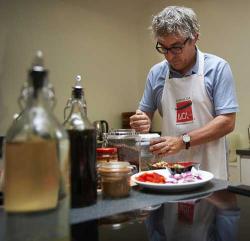 The thigh meat is his meat of choice, he laughs off my suggestion of breast. “In Chinese cooking we tend to use that more for stocks, it doesn’t have the flavour for main dishes we find. And thigh meat is cheaper, anyway.’ He adds Sesame oil, sugar, Chinese 5 spice, and light soy sauce to the meat and then some cornflour.’Just enough to make the marinade look creamy,’ he explains. ‘We don’t add the cornflour at the end of cooking as some people do, that makes the sauce thicken okay but it doesn’t make the chicken crispy which is what we want here.’
The thigh meat is his meat of choice, he laughs off my suggestion of breast. “In Chinese cooking we tend to use that more for stocks, it doesn’t have the flavour for main dishes we find. And thigh meat is cheaper, anyway.’ He adds Sesame oil, sugar, Chinese 5 spice, and light soy sauce to the meat and then some cornflour.’Just enough to make the marinade look creamy,’ he explains. ‘We don’t add the cornflour at the end of cooking as some people do, that makes the sauce thicken okay but it doesn’t make the chicken crispy which is what we want here.’
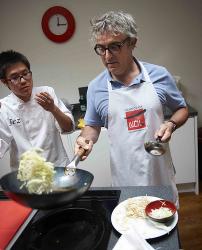 And so to wok, using a ladle for everything is handy and saves on washing up. I get some oil, never sesame or olive oil; they have too low a smoke point and will burn long before they reach the high temperature required. Jeremy advises drizzling the oil down the sides of the wok in a circular motion and then watching for the smoke. As soon as it gets to that point, in goes the onion and red pepper. I stir the way Jeremy advises, pulling the veg from back to front using the ladle edge so that everything is evenly exposed to the heat. After a few minutes the veg are pushed to the back of the wok and more oil added before adding in the chicken garlic and peppercorns.
And so to wok, using a ladle for everything is handy and saves on washing up. I get some oil, never sesame or olive oil; they have too low a smoke point and will burn long before they reach the high temperature required. Jeremy advises drizzling the oil down the sides of the wok in a circular motion and then watching for the smoke. As soon as it gets to that point, in goes the onion and red pepper. I stir the way Jeremy advises, pulling the veg from back to front using the ladle edge so that everything is evenly exposed to the heat. After a few minutes the veg are pushed to the back of the wok and more oil added before adding in the chicken garlic and peppercorns.
I bring the veg back on top of the chicken so they are protected from too much cooking and when signs of excess heat occur I do the’flip’, soon I’m getting quite good at it and feeling very professional and confident. Once the chicken is golden, in goes chilli paste, rice wine and soy sauce, the fresh chillies and cashew nuts. Job done.
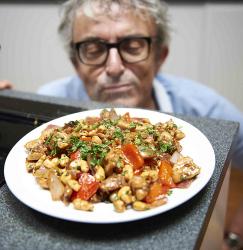 To go with it I make fried noodles after Jeremy explains to me how to deal with dried noodles, and that in itself is an eye opener. Adding Chinese greens and bean sprouts I cook them all fast and furiously, then add some dark soy sauce and serve the two dishes up. Although I say it myself, it’s delicious and photographer Al is impressed as he chases the cashews about with his chopsticks.
To go with it I make fried noodles after Jeremy explains to me how to deal with dried noodles, and that in itself is an eye opener. Adding Chinese greens and bean sprouts I cook them all fast and furiously, then add some dark soy sauce and serve the two dishes up. Although I say it myself, it’s delicious and photographer Al is impressed as he chases the cashews about with his chopsticks.
You can read books, you can watch TV shows but nothing beats hands on experience with an expert at your side every step of the way. Now I can do the flip and understand wok cooking on a visceral level, I’ll be getting the wok out more regularly in the week. Wok on!
